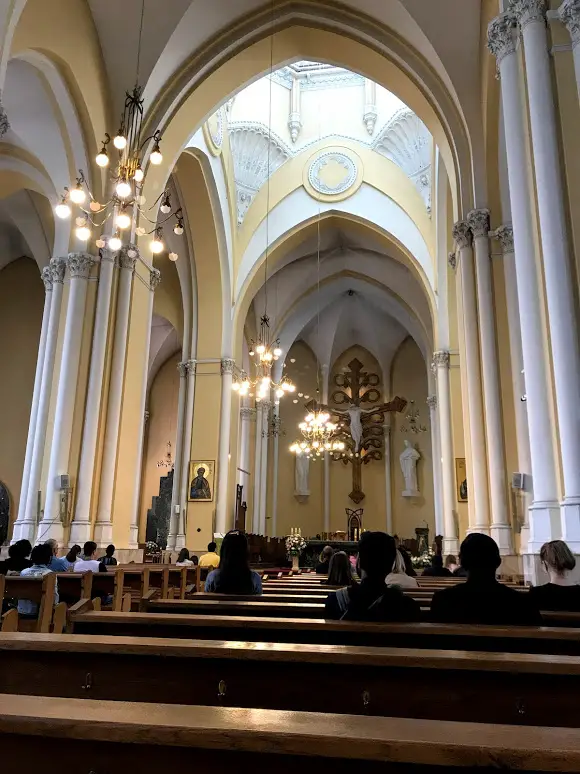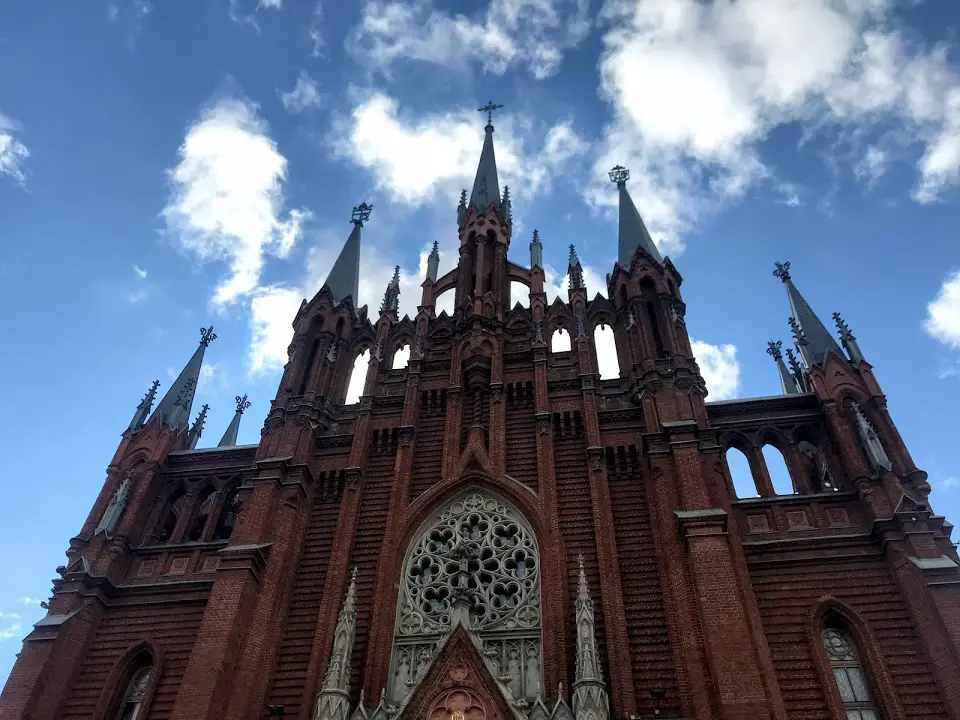In coming to Moscow, I understood that I probably wouldn’t be able to attend church every Sunday, but I was looking forward to exploring the Catholic Church in a different country. I figured there would be services available in both English and Russian, and so I planned on attending Mass in English first to get a feel for it before going to whichever service worked with my schedule best.

The Cathedral of the Immaculate Conception of the Holy Virgin Mary, or Собор Непорочного Зачатия Пресвятой Девы Марии, is located slightly outside of the city center, just a ten-minute metro ride from the HSE student dorms. A gorgeous example of Gothic architecture, the church’s many spires can be seen from a block away – a welcome landmark the first time I navigated the 15-minute walk from the metro station to the cathedral itself.
Perusing the website, I was surprised to find that while services in many international languages are available – including Spanish, Portuguese, French, and Polish – only one English service was offered per week. This service, given at 3:00pm Sundays, often conflicted with my SRAS cultural program, and so it was not until around halfway through my time in Moscow that I was finally able to attend Mass.
I arrived a little after 3:00 (oops) to find that the Spanish service, which had begun at 2:30, was still in full swing. Although I also speak Spanish, I took a seat on the edge and took a moment to enjoy my surroundings. While still designed in the Gothic style, the church’s interior seemed completely at odds with its foreboding facade, painted in light and airy yellow and white. Pointed arches soared on top of ornate Corinthian columns, marble floors gleaming from the sunlight streaming through the stained glass windows.

Within the half hour, the Spanish service came to a conclusion. It was well after the time when the English service was slated to start, and I couldn’t remember what the schedule had planned for 3:30. So I sat to wait as one set of churchgoers left and was replaced by another, keenly aware that I would have to leave by 4:00 to make the plans I had for the evening.
As soon as the 3:30 service began, I knew I had missed the English service. I later learned that I had attended the Armenian rite. A small group of men, all in heavily adorned gold and red garments, approached the altar, with the priest wearing a bishop’s mitre on his head. The men traversed the nave at the beginning of the service with a thurible, and the sweet scent of incense soon filled the air. A large part of the service was conducted in the format of call and response, with the men intoning the prayers and the women responding. However, if my closest neighbors were anything to go by, the majority of the congregation seemed to say nothing at all, simply crossing themselves periodically throughout the service.
The sound bounced off the hard walls, making it very difficult for me to distinguish which language they were speaking, much less whether or not I understood it, so I did my best to follow along, sitting, standing, and crossing myself with my neighbors. I couldn’t help but notice that the man in front of me failed to cross himself for the majority of the service, and I wondered if, like me, he had come for a different service.
When it came time for the homily, I was finally able to distinguish enough of what was being said to understand the basic gist, my ears having adapted to the echoey acoustics of the building. As I had attended the Armenian rite, however, the entire Mass was most likely in Armenian, so I may have misunderstood the message completely.
I unfortunately had to leave soon after, but I was glad to see that my departure would not be too disruptive – people had milled about the nave throughout the entirety of both services, preparing for the next service or otherwise appreciating the church’s beauty. One man seemed to be there for the sole purpose of shaking everyone’s hand during the rite of peace.

Happy to have successfully found the church but disappointed in my failure to successfully go to an entire service, I looked forward to my next free Sunday. This Sunday happened to be my last in Moscow. I had gone back to the cathedral’s website to find that the English service took place in the crypt, which my map suggested was located across the street from the cathedral. Cognisant of the fact that this was my last opportunity, I decided to arrive in time for the Spanish service and, if I was unable to find the chapel in the crypt, then at least I would be able to attend an entire service.
I looked for the crypt across the street and on the cathedral grounds without luck, filing into the cathedral for some much needed practice of my Spanish skills. As I started learning Spanish at a Catholic school, I found the service’s familiarity comforting. I enjoyed picking out all of the different varieties of Spanish heard, from the distinctive lisp of an accent from Spain itself to the pervasive “sh” of Argentinian Spanish, and by the end of the service, I found myself wishing it wasn’t my last Sunday in Russia.
To any Catholics visiting Russia, I highly recommend biting the bullet and attending Mass in Russian. Services are available throughout the day, and the atmosphere is relaxed enough that the language barrier should not be much of a problem. Particularly as I was in Russia for the purpose of studying Russian, I regret not having one more free Sunday to attend Mass in my target language. It’s definitely something high on my bucket list for when I come back.





